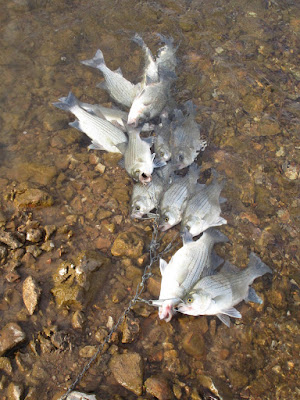It isn’t much of a creek in the summer, but miles above where it flows into an Ozark lake, you can find it bank full in the spring. There are lots of those kinds of creeks in the Ozarks. They don’t have spectacular bluffs but there are rocky outcroppings along the deep-water sides and out from those there are some deep holes even in the dry season.
They are isolated; with difficult shoals this time of year when the water is high, which become shallow riffles after a month of little rain. But they are peaceful, lonely little waters where you can pretend it is 100 years ago. No canoe renters are found along them, no beer cans, no hollering.
So the other day I gets to thinking that I might find a few nice bass in some of those creek eddies, now about right to float with the water conditions we have. I put my shortest johnboat in at a low water bridge, fixin’ to float a few hours and take some pictures and cast a few spinner-baits and come out at a farm crossing maybe 3 or 4 miles down the creek.
Did I get a surprise when I got there! The normally murky waters found in the spring were crystal clear, and you don’t fish anything above an eighth of an ounce in spring-water, which is what I seemed to be floating through. So I put up the spinner bait and went to my light spinning gear and a 3-inch long Rapala and in the next 2 hours I did indeed have a great time catching a few little bass about 12 or 13 inches long, bending that light rod like they were lunkers.
Then I came to a hole maybe 2 miles above the lake and made a cast whilst enjoy the sight of two old geese trying to get 4 goslings to hide from me. The little ones were about the size of mallards, with longer necks of course, still a little bit downy and yellow colored. Momma goose slid down beside a log and flattened out with her head on the ground, and shortly the gander and the goslings did the same. I took some photos, leaving my lure out several feet from my boat. In the middle of my photography, there was a commotion on the water where my lure had been and something took it under, nearly jerking my rod and reel out of my boat.
I grabbed it, and my light rod just bent over with the weight of the fish. What a fight it was, and I won. I pulled a 15-inch white bass into the boat, a female with a bulging belly, five inches across. I looked down into the clear hole I had drifted into and I could see a dozen more of them, swirling around in a mass of ready-to-spawn white bass. I backed the boat up quietly, got out on the bank and started catching them, working that little topwater lure on the surface, nailing a hard-fighting white bass on about every third cast.
At one time I caught five of them on five consecutive casts. As it grew later in the day, after stringing my limit of the hard- fighting white bass, I caught another 20 or so and released them. About a third of them were males, and there were plenty of big hefty females. Cleaning them later I found that some of the females had not deposited their eggs but were reabsorbing them. That seems to be a normal occurrence in the spring.
Everything I caught was above 12 inches and I landed some that were 16 inches long. You really can’t say that the hardest fighting fish for its size is a smallmouth, though they are what I would rather fish for than anything else. You catch a sixteen-inch white bass and the struggle to land it, and the length of the fight, will equal that of a 16-inch smallmouth, especially in flowing current.
The white bass that day were situated in two holes that were about 8 or 9 feet deep, with a little bit of flow. They likely spawned that night or in nights to come. At night, I am sure more of them arrived because I went back the next day and caught 30 or 40 more of them.
White bass will easily move up a tributary but it is done at night in clear water, and they can swim over a shoal in only four inches of water. I have watched them spawn in clear shoals at night and it is something to see, the water glistening with silver bodies, turning sideways in flowing water, releasing eggs by the thousands, with males beside them fertilizing those eggs, which then roll in the current over the gravels.
Their migration in large streams can go for miles and miles. I am sure the ones I found in that small creek had traveled 8 or 10 miles to spawn. There were good shoals downstream for spawning, but it seems that where they were, was something perfect for them. How long will there be white bass there? I think they will be up that creek for another couple of weeks, some coming and some going, if the rain doesn’t keep the creek too high and muddy.
But I doubt if I get back there. I am going down into Arkansas soon to fish for other species. You might say I have other fish to fry.
I have a new book out this week for those who are interested. E-mail me at lightninridge47@gmail.com or call my office to find out how to get a copy. The number is 417-777-5227.



No comments:
Post a Comment